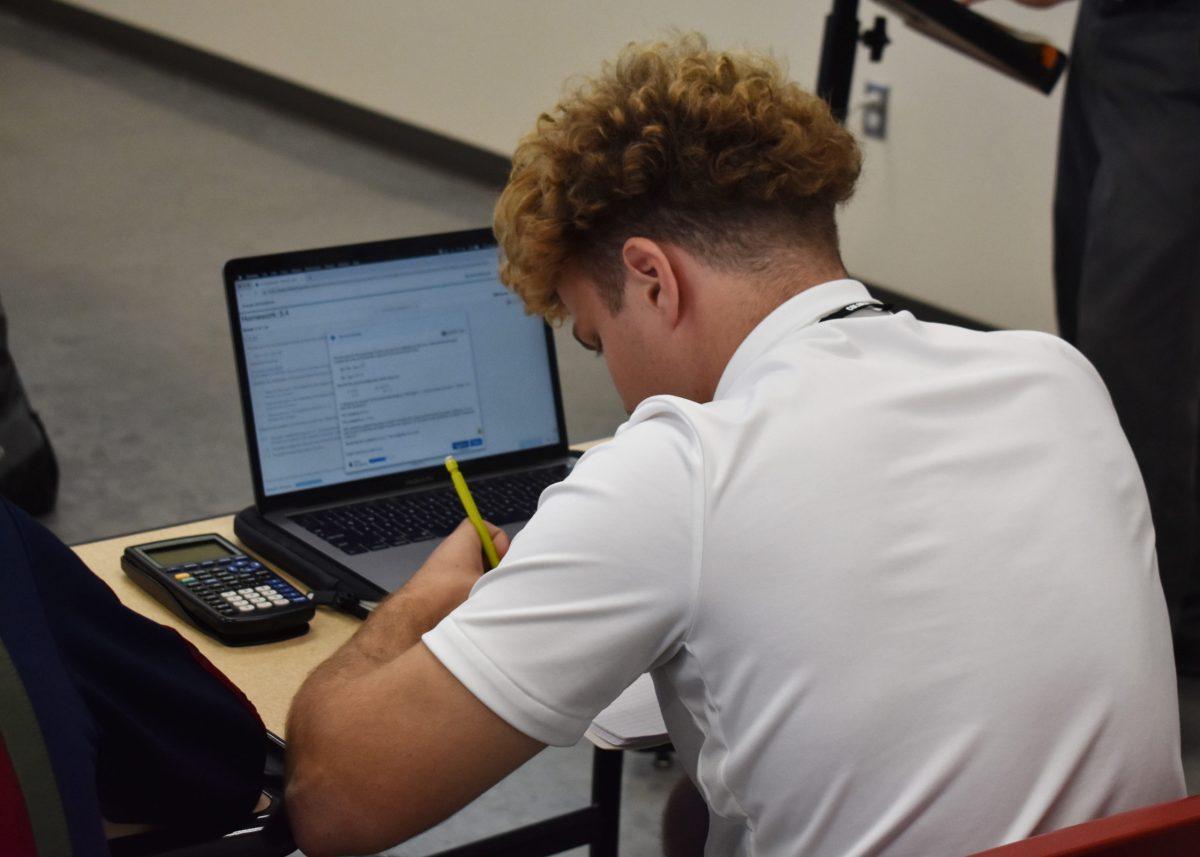Photo by Nick Pecora ’21 | A student works through practice problems while Mr. Doug Cox gives a supplemental lecture in his Pre-Calculus class on Nov. 7, 2019. These problems would be completed as homework in a traditional classroom setting.
By Nick Pecora ’21
THE ROUNDUP
A recent study has shown that the “flipped classroom” method is not only popular among students but allows them to learn more successfully as well.
The study, published by the American Educational Research Association, defines the flipped classroom as “a teaching model that moves most of the teacher-centered instruction out of the classroom to free up time in the classroom for more student-centered learning activities.”
The intention behind the model is to allow students to learn at their own pace and to give them the ability to do their work in a setting where a teacher is present to address any questions that may arise while the students complete their work.
On Brophy’s campus, the teaching method is used in many math classrooms, including that of Mr. Doug Cox, who has been using the flipped classroom for about ten years.
As part of his flipped classroom, Mr. Cox provides a YouTube channel filled with self-made instructional videos to assist his Honors Algebra II students with their coursework. “With the video lessons, you can watch them as many times as you want, you can rewind them, you can pause them,” Mr. Cox said regarding the flexibility that the model provides for his students.
He also appreciates the opportunity granted by the use of the flipped classroom to provide individualized help during class to help as many students as possible during class. “You have a lot more time in class to go over questions students ask and give a lot more one-on-one help, and it just frees up a lot more time in class to really reinforce the material,” Mr. Cox said.
However, there are some students who prefer a more traditional setting, a preference that Mr. Cox also tries to accommodate in class through “supplemental lectures.” “I also try to incorporate in-class lessons in addition to the other activities and Q and A time that we have during class time,” Mr. Cox said regarding his commitment to satisfying various learning preferences.
Many students have had positive reactions to the flipped classroom, enjoying the flexibility and individualized learning process that it provides. However, the reality is that for all its benefits, the flipped classroom model comes with some drawbacks as well.
William Hays ’21 has taken two math classes at Brophy that have utilized the flipped classroom approach. He has noticed that, while the flexibility provided to students is a good thing, that level of freedom can ultimately harm some students’ learning.
Hays noted that “Sometimes [the flipped classroom] allows for students to put off actually learning the coursework until it’s time for an assessment,” which could lead to greater levels of stress for students who end up cramming before tests.
However, Hays continued that, despite the flipped classroom’s flaws, “the freedom it gives you outweighs [the potential added stress].”
At Brophy, the flipped classroom is utilized exclusively in math classrooms. Brophy’s Assistant Principal for Academics, Mr. Seamus Walsh, attributed this phenomenon to math “[lending] itself to a flipped classroom because there is an instructional component and then there is a practice component.”
Regarding the potential benefits of taking or viewing notes at home and working through exercises in class, Mr. Walsh continued, “[The] instructional component is really about absorbing the concepts and internalizing an understanding of them, and the practice is … where kids may struggle. It’s best to have a teacher on hand to help with that.”
While the flipped classroom can be helpful to students who struggle with certain math concepts and require extra help, it can also benefit students to whom math comes easily.
One problem that arises from use of a traditional classroom is the occasional lack of engagement from students. “If a kid gets it in the first two minutes, he’s bored out of his mind, so he’s sitting there just falling asleep or daydreaming,” Mr. Walsh said. However, Mr. Walsh continued, with a flipped classroom, “If he gets it in the first minute when he’s at home, he can just stop the video, be done with it, and either start working through problems or do the problems the next day,”
While math uniquely lends itself to the flipped classroom model, there is a place for the method in other subjects as well. Though it would be difficult for an entire non-math course to fully use the flipped model, there are some assignments in which the method could prove effective.
Mr. Walsh provided an example of one scenario in which the model could be used in an English class: “… a writing assignment where a teacher is walking the room, helping kids troubleshoot their own writing in real time and maybe what they did at home was … read an article or watch a video on how to, for example, construct a dramatic monologue.”



















